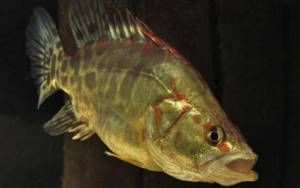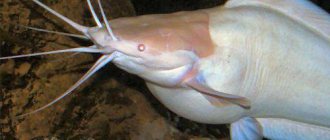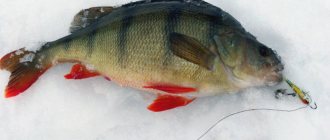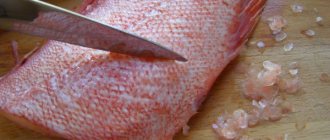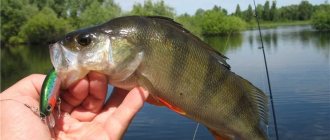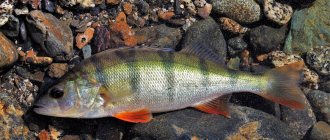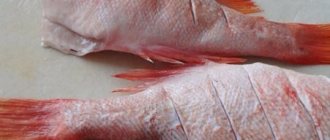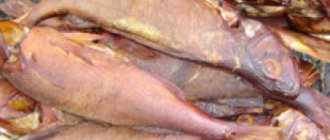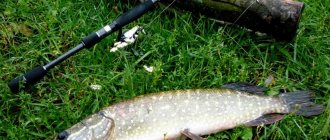What does Chinese snapper look like?
The aukha is a large bottom-dwelling fish, up to 70 cm long. Its massive, tall body is compressed from the sides, in the back area it is colored brown, yellow-green and covered with dark spots of arbitrary shape, the scales are round. The fins have a bright color: yellow-orange and reddish with black splashes. The dorsal fin has up to 17 soft and 11-12 spiny rays, the anal fin has 3 large spines. Perch has a large head and mouth. Life expectancy is up to 13 years.
Weight Limit
As a large predator, the aukha perch is capable of gaining weight quite quickly. At 4-5 years old, fish reach a size of 30-35 cm with a weight of 700-1200 g. It reaches its maximum weight by 13 years - up to 8.6 kg with a length of 70 cm.
Representatives of marine perch species are gigantic in size and weight. Thus, the maximum size of the Warsaw rockfish, or black grouper, was 104 cm with a weight of 134 kg. It is an inhabitant of the coastal waters of the United States and Cuba.
Description
Many people know perch, but not many have heard of its Chinese relative.
Perch-auha, Chinese perch - that’s what they call it. A freshwater predator, quite large in size, grows up to 9 kg and can be up to 70 cm long. Lives no more than 10 years. Aukha has a rather tall, humpbacked body, flattened laterally. The fin is double, the back part is longer and not as spiny as the front. The lower jaw protrudes beyond the upper jaw. The large head and large toothed mouth indicate a voracious predator.
This perch is very beautiful, with dark, leopard-print spots, marsh, light brown or gray scales, and bright, orange-yellow-black fins. It’s not for nothing that in China they call it “mandarin duck”.
Lifestyle and behavior of a voracious predator
Chinese perch prefers the beds of large rivers and lakes with calm, warm water; it prefers not to enter cold mountain streams. Auhi is widespread in Korea, where it is a popular food item. On the territory of Russia they can be found in the Amur River (everywhere except the upper reaches), in its tributaries, on Lake Hanko, in the northwestern part of Sakhalin (Lake Sladkoe).
The aukha spends the summer months in floodplain reservoirs and rivers, and after the autumn cold snap it swims into the riverbed. Fish winter in the river bed. Cupid, being almost motionless.
Fish spawning occurs in June-July, when it is in the middle reaches of the Amur and its tributaries, the Ussuri and Sungari. Puberty is completed by 3-5 years, when the body size reaches 32-34 cm. The optimal temperature for the start of spawning is +20...+26°C. Spawning takes place in portions, eggs are thrown directly into the water. The diameter of the eggs is 1.9−2.2 mm.
Collected by the flow of water, the fry settle in nearby reservoirs located along the middle and lower reaches of the Amur, some of them end up in the Amur Estuary. The number of eggs from one female ranges from 48 to 380 thousand pieces.
The juveniles that hatch after 3-4 weeks grow quickly, feeding on fish larvae. Already at a size of 5-6 cm, it is capable of feeding on the fry of other small fish species. Moreover, sometimes aukha fry attack prey that is twice their size - they break it in two and then swallow it, starting from the tail.
Nutritional Features
The diet of adult aukha perches consists of minnows, bleaks, chebaks, razorbacks and other low-bodied fish species. If there is not enough food, they switch to river killer whales, and can swallow them right with their spines. Perches hunt on the border strip between a quiet backwater and a fast current; they also eat larger crucian carp.
Auhi live alone, preferring not to gather in flocks. During the hunt, they are able to hide and sit in ambush, waiting for the prey. Then they attack, instantly making a throw.
Brief description of the predator
Chinese perch has a bright, memorable appearance. Despite the fact that the body structure is not much different from the constitution of other fish, it has its own characteristics.
External description of the type:
- the head is large, occupies a third of the body, looks a little disproportionate;
- the oral cavity is mobile, pops out when capturing prey;
- The jaws are strong, equipped with fangs and small teeth in several rows. The lower one extends above the upper one;
- the eyes are large, mobile, in harmony with the head;
- the gill covers are serrated, and the body and cheeks are covered with small scales;
- the fins are rounded, there is a double dorsal, a pair of pectoral fins, an anal (equipped with two spines), and a caudal fin.
The habitat is extensive. Perch is common in Primorye, water bodies of China and Korea. Present in the Amur and its tributaries, lakes Khanka and Sladkoe on Sakhalin.
Spends the summer season in small lakes, in the fall it moves to the beds of large rivers with a uniform flow. The average lifespan of a fish is 8-9 years.
Biological features of aukha fish
According to the biological classification, all fish belong to aquatic vertebrates, a group of gnathostomes. However, animals do not have special organs for breathing (gills) or for swimming.
Chinese auha perch (lat. Siniperca chua-tsi) belongs to the family of Rock perches of the order Perciformes, which are distinguished by the presence of 2 parts on the dorsal fin (soft and spiny) and bristle-like teeth on the jaw. The family is divided into 9 genera and more than 100 species.
In the Amur River, Chinese perches have always been found in large numbers. In the middle of the 20th century. the annual catch was 25 tons, of which in Russia - 17 tons. However, in the 1970s and 80s. the number of fish has decreased.
The reasons for the decline in the number of aucha were insufficient nutrition, water pollution and heavy fishing in spawning grounds located in other countries (China, Korea). Therefore, in 1981, the aukha was listed in the Red Book, and therefore its catching was completely prohibited and recommendations were made for its artificial reproduction.
In Russia there is an annual ban on fishing for aukhi, especially during the spawning season. This is sufficient to maintain the required number of fish of this species. This has a beneficial effect on the state of the ecosystem. Now the threat of extinction for the Chinese perch no longer exists, so scientists recommend transferring it to category 5.
Other interesting fish of the perch family - list and biological parameters:
- common perch - common in freshwater and brackish waters of Europe and Asia;
- Thai Siamese tiger perch - lives in rivers and swamps of southeast Asia (Thailand, Borneo, Sumatra, etc.), is distinguished by vertical black stripes along the body, in nature their length can reach 45 cm, life expectancy - up to 15 years, leads predatory lifestyle;
- marbled perch - belongs to the marine species, lives in the western regions of the Pacific Ocean, off the coast of Japan, the Philippines, China and the Korean Peninsula;
- Pineapple, or the creeping perch of Indochina, is common in the freshwater waters of South Asia and the Philippines; this is the only perch that can breathe atmospheric air - it has a special epibranchial organ, which it uses to move on the ground, relying on its fins, from one body of water to another when they dry out, the body length is 10-25 cm;
- Siamese four-striped perch, or striped lobot, is an active predatory fish up to 30 cm long, living in the reservoirs of Thailand, Cambodia and the islands of Sumatra and Borneo, endowed with a contrasting black and white color, can be kept in an aquarium;
- largemouth bass, or bass, is a species that belongs to the black perch that inhabit the sea waters of the coast of North America, now found in the waters of Southern Europe, Japan, New Zealand and Africa, where it was released for resettlement, has a large mouth with a large lower jaw , body color - olive green with spots, body length - up to 75 cm with a weight of 11 kg.
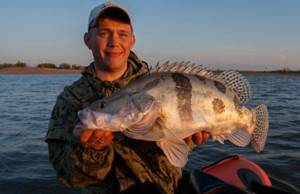
Number and threats to the population
In the Amur, the aukha has always been a relatively small species. In the post-war years, the total annual catch of aukhi in the Amur did not exceed 25 tons, of which 17 tons in Russia. In the 70-80s, “it was found in single copies”, on the basis of which it was included in the Red Book by M.L. Krykhtin. One can argue with this statement. Probably, “on average” it actually occurred sporadically in the 70-80s, but the author of this report in July 1986 personally observed in Yelabuga at the fishing site of a fishing team that the catches of floating nets were almost ? in number they consisted of aukhi. However, due to the ban on its fishing, it was stolen by fishermen for personal consumption and was not taken into account in fishing statistics. In the 70s, the author of this report, while still a schoolboy, easily caught exactly as many aukhi fry in the Amur Channel for observations in the aquarium as was necessary. Surprisingly, at present there are clearly fewer larvae and fry of aukhi in Khabarovsk than there were 2-3 decades ago. At the same time, its teenagers are quite often caught by us with a cap net and a net; aukha is not at all uncommon in the catches of floating and fixed nets on the Lower Amur; there is a lot of it in the food market; and even in the catches of amateur fishermen it is not uncommon in recent years. The latter circumstance has not been observed before. Catching an aukha on a hook in the 70s and 80s was an extraordinary phenomenon. According to some reports, in recent years Chinese fish farmers have been engaged not only in pond cultivation of aukhi, but also in the release of its grown-up juveniles into natural reservoirs. Perhaps this is the main reason for the relatively high number of aukha on the Lower Amur in recent years, with relatively weak natural spawning.
Conservation measures. An annual ban on fishing for small fish in the Amur during their spawning period is sufficient to maintain the required number of this species in the ecosystem. There is no threat of extinction of the aukha in the Amur, and therefore it is advisable to remove the species from the Red Book or transfer it to the fifth category (according to the IUCN classification).
compiler and photo: G. V. Novomodny, Khf TINRO
Culinary value
Like all representatives of the perch fish family, the meat of auch has good taste. The beneficial properties of this product are determined by its valuable chemical composition:
- contains valuable polyunsaturated fatty acids Omega-3, which most importantly affects the functioning of the brain and thyroid gland;
- normalizes blood sugar levels;
- useful minerals (potassium, magnesium, calcium, phosphorus, sodium, iron, etc.) and vitamins (groups A, E, D, C, B and PP) - help improve the metabolism of fats in the body, saturate tissue cells with oxygen;
- phosphorus - helps strengthen bones and skeletal tissues;
- normalizes the functioning of the digestion and nervous system, improves the condition of the mucous tissues of internal organs and the epidermis.
The calorie content of freshwater perch meat is quite low - 82−91 kcal per 100 g. Due to its vitamin and mineral components, low calorie content and low fat content (less than 1%), it is classified as a healthy dietary food. It is recommended for use by those who want to lose weight by eating seafood.
Artificial breeding
Fish farmers in China have been breeding and growing perch on farms for several years now. In Russia, the first attempts to breed perch artificially were made in the Primorsky Territory back in 1959. Then similar experiments were carried out at the Azov cage base.
In 2014, the decision to artificially breed Chinese perch was made after its numbers sharply declined following intensive fishing in the main spawning grounds. 4 large specimens of aucha (1 female and 3 males) weighing up to 4.9 kg were caught in the Melgunovka River near Lake Khanka in Southern Primorye, with which they conducted experimental breeding. The result was the decision that Chinese perch can be grown artificially in the conditions of Southern Primorye, but taking into account some recommendations from scientists.
Distribution and habitats
Abroad, the aukha is found in the rivers of the People's Republic of China and Korea. In Russia, it lives mainly throughout the entire area of the middle Amur, in its tributaries (Ussuri, Sungari) and in Lake Khanka. Occasionally found on Sakhalin. There it is mostly seen on the northwestern coast of Lake Sladkoe. Chinese perch tries to avoid cold mountain rivers and streams. Aukha loves clean, warm water, so it often enters small floodplain lakes during high water. After spawning, the perch is distributed in the Amur riverbed and floodplain reservoirs. All summer he gains weight by eating intensively. In autumn it moves to the Amur riverbed for wintering. Both young and adult individuals spend the cold season there, leading a sedentary and half-asleep lifestyle at the very bottom. And next spring, immediately after the ice drift, it sharply intensifies again.
